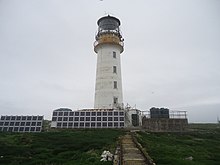Sule Skerry
| Location | |
|---|---|
North Atlantic | |
| Area | 16 ha (40 acres) |
| Highest elevation | 12 m (39 ft) |
| Administration | |
| Sovereign state | United Kingdom |
| Country | Scotland |
| Council area | Orkney |
| Demographics | |
| Population | 0 |
| References | [1][2][3] |
| Sule Skerry Lighthouse | |
 | |
| Coordinates | 59°05′05″N 4°24′26″W / 59.084713°N 4.407325°W |
| Constructed | 1895 |
| Built by | David Alan Stevenson, Charles Alexander Stevenson |
| Construction | masonry tower |
| Automated | 1982 |
| Height | 27 m (89 ft) |
| Shape | cylindrical tower with balcony and lantern |
| Markings | white tower, black lantern, ochre trim |
| Power source | solar power |
| Operator | Northern Lighthouse Board[4][5] |
| Heritage | category A listed building |
| Focal height | 34 m (112 ft) |
| Lens | "hyperradiant" Fresnel lens |
| Range | 21 nmi (39 km) |
| Characteristic | Fl (2) W 15 s |
Sule Skerry is a remote
Geography
Sule Skerry lies 60 kilometres (32 nautical miles) west of the
Sule Skerry is 16 hectares (40 acres) in area and about 800 m (1⁄2 mi) long.[6] It reaches a height of 12 metres (40 feet).[7] It is formed of Lewisian gneiss.[8]
Biology
Sule Skerry together with Sule Stack are listed as a Special Protection Area as they are home during the breeding season to thousands of puffins and gannets and smaller numbers of the rarer Leach's storm petrel and storm petrels. Note that Leach's petrel visit the island but breeding is not proved. Since the first visiting birds in 2003 there is now a large breeding population of gannets; a possible overflow from nearby Sule Stack.
Every three years the puffins and other seabirds on Sule Skerry are monitored by a team of birders called the Sule Skerry Ringing Group. They have been monitoring the seabirds on the island since 1975.
The island is treeless, since few trees would withstand the high winds of winter and salt spray environment. The dominant plant is maritime mayweed (Tripleurospermum maritimum).
Lighthouse


There is a lighthouse at the centre high point of the island and a number of small cairns around the periphery.
According to the
A meteorological buoy used in Met Office's Marine Automatic Weather Station (MAWS) Network is located off Sule Skerry. Results from the buoy are used in the Shipping Forecast.
Folklore
"The Great Silkie of Sule Skerry" is a story of a Silkie who lives on Sule Skerry.
See also
- List of islands in Scotland
- List of lighthouses in Scotland
- List of Northern Lighthouse Board lighthouses
- List of outlying islands of Scotland
References
- ^ National Records of Scotland (15 August 2013). "Appendix 2: Population and households on Scotland's Inhabited Islands" (PDF). Statistical Bulletin: 2011 Census: First Results on Population and Household Estimates for Scotland Release 1C (Part Two) (PDF) (Report). SG/2013/126. Retrieved 14 August 2020.
- ISBN 978-1-84195-454-7.
- ISBN 9780319228128.
- ^ Rowlett, Russ. "Lighthouses of Scotland: Orkney". The Lighthouse Directory. University of North Carolina at Chapel Hill. Retrieved 12 May 2016.
- ^ Sule Skerry Northern Lighthouse Board. Retrieved 12 May 2016
- ^ SPA description
- ^ National Geospatial-Intelligence Agency: Sailing Directions (Enroute), Pub. 141, Scotland.
- ISBN 978-0-632-01605-1.
